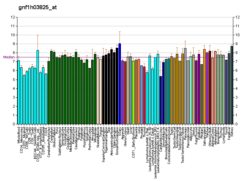NAV1
Neuron navigator 1 is a protein that in humans is encoded by the NAV1 gene.[5][6][7]
This gene belongs to the neuron navigator family and is expressed predominantly in the nervous system. The encoded protein contains coiled-coil domains and a conserved AAA domain characteristic for ATPases associated with a variety of cellular activities. This gene is similar to unc-53, a Caenorhabditis elegans gene involved in axon guidance. The exact function of this gene is not known.[7]
References
- 1 2 3 GRCh38: Ensembl release 89: ENSG00000134369 - Ensembl, May 2017
- 1 2 3 GRCm38: Ensembl release 89: ENSMUSG00000009418 - Ensembl, May 2017
- ↑ "Human PubMed Reference:".
- ↑ "Mouse PubMed Reference:".
- ↑ Maes T, Barcelo A, Buesa C (Jun 2002). "Neuron navigator: a human gene family with homology to unc-53, a cell guidance gene from Caenorhabditis elegans". Genomics. 80 (1): 21–30. PMID 12079279. doi:10.1006/geno.2002.6799.
- ↑ Coy JF, Wiemann S, Bechmann I, Bachner D, Nitsch R, Kretz O, Christiansen H, Poustka A (Jun 2002). "Pore membrane and/or filament interacting like protein 1 (POMFIL1) is predominantly expressed in the nervous system and encodes different protein isoforms". Gene. 290 (1–2): 73–94. PMID 12062803. doi:10.1016/S0378-1119(02)00567-X.
- 1 2 "Entrez Gene: NAV1 neuron navigator 1".
Further reading
- Kimura K, Wakamatsu A, Suzuki Y, et al. (2006). "Diversification of transcriptional modulation: Large-scale identification and characterization of putative alternative promoters of human genes". Genome Res. 16 (1): 55–65. PMC 1356129
 . PMID 16344560. doi:10.1101/gr.4039406.
. PMID 16344560. doi:10.1101/gr.4039406.
- Peeters PJ, Baker A, Goris I, et al. (2004). "Sensory deficits in mice hypomorphic for a mammalian homologue of unc-53". Brain Res. Dev. Brain Res. 150 (2): 89–101. PMID 15158073. doi:10.1016/j.devbrainres.2004.03.004.
- Ota T, Suzuki Y, Nishikawa T, et al. (2004). "Complete sequencing and characterization of 21,243 full-length human cDNAs". Nat. Genet. 36 (1): 40–5. PMID 14702039. doi:10.1038/ng1285.
- Okazaki N, Kikuno R, Ohara R, et al. (2003). "Prediction of the coding sequences of mouse homologues of KIAA gene: II. The complete nucleotide sequences of 400 mouse KIAA-homologous cDNAs identified by screening of terminal sequences of cDNA clones randomly sampled from size-fractionated libraries". DNA Res. 10 (1): 35–48. PMID 12693553. doi:10.1093/dnares/10.1.35.
- Strausberg RL, Feingold EA, Grouse LH, et al. (2003). "Generation and initial analysis of more than 15,000 full-length human and mouse cDNA sequences". Proc. Natl. Acad. Sci. U.S.A. 99 (26): 16899–903. PMC 139241
 . PMID 12477932. doi:10.1073/pnas.242603899.
. PMID 12477932. doi:10.1073/pnas.242603899.
- Nakayama M, Kikuno R, Ohara O (2003). "Protein–Protein Interactions Between Large Proteins: Two-Hybrid Screening Using a Functionally Classified Library Composed of Long cDNAs". Genome Res. 12 (11): 1773–84. PMC 187542
 . PMID 12421765. doi:10.1101/gr.406902.
. PMID 12421765. doi:10.1101/gr.406902.
- Nagase T, Ishikawa K, Kikuno R, et al. (2000). "Prediction of the coding sequences of unidentified human genes. XV. The complete sequences of 100 new cDNA clones from brain which code for large proteins in vitro". DNA Res. 6 (5): 337–45. PMID 10574462. doi:10.1093/dnares/6.5.337.
- Hirosawa M, Nagase T, Ishikawa K, et al. (2000). "Characterization of cDNA clones selected by the GeneMark analysis from size-fractionated cDNA libraries from human brain". DNA Res. 6 (5): 329–36. PMID 10574461. doi:10.1093/dnares/6.5.329.
 . PMID 16344560. doi:10.1101/gr.4039406.
. PMID 16344560. doi:10.1101/gr.4039406. . PMID 12477932. doi:10.1073/pnas.242603899.
. PMID 12477932. doi:10.1073/pnas.242603899. . PMID 12421765. doi:10.1101/gr.406902.
. PMID 12421765. doi:10.1101/gr.406902.



